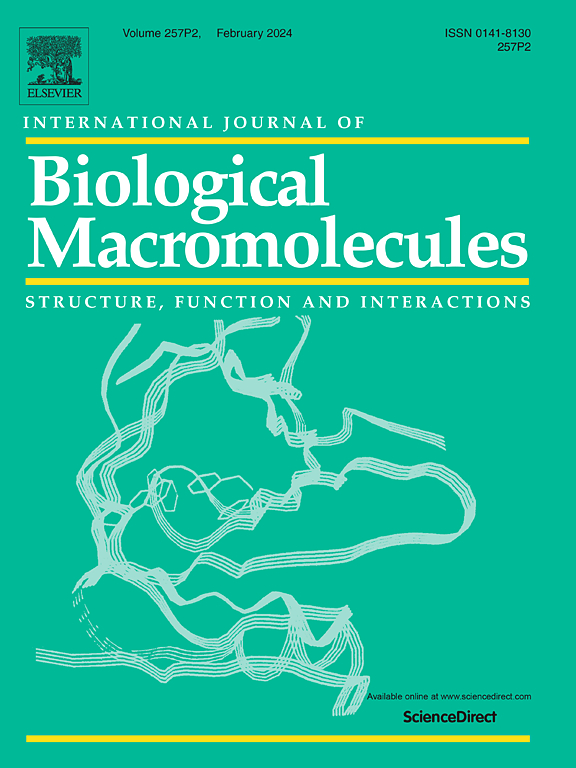Microenvironment-responsive collagen hydrogel with Houttuynia Cordata Thunb vesicles for diabetic wound repair
IF 7.7
1区 化学
Q1 BIOCHEMISTRY & MOLECULAR BIOLOGY
International Journal of Biological Macromolecules
Pub Date : 2025-07-09
DOI:10.1016/j.ijbiomac.2025.145840
引用次数: 0
Abstract
Wound healing in diabetic patients is often impaired due to a combination of tissue inflammation, excessive reactive oxygen species (ROS), insufficient neovascularization, and pH imbalances. To overcome these challenges, we designed a multifunctional hydrogel system capable of responding to the wound microenvironment and enabling the controlled release of plant-derived extracellular vesicles (PDEVs) to accelerate diabetic wound healing. The hydrogel was constructed using recombinant human Type III collagen (rhCOL3) grafted with 3-aminophenylboronic acid (APBA) to gain the microenvironment response ability. Additionally, PDEVs derived from Houttuynia cordata thunb (HC-EVs) were embedded within the hydrogel to improve the biological ability. This HC-EVs-loaded BA-rhCOL3 hydrogel (HC-EVs@B-CH) demonstrates excellent tissue adhesion, self-healing properties, and notable antioxidant and anti-inflammatory effects. By regulating the wound microenvironment, it significantly enhances diabetic wound healing through improved angiogenesis, increased collagen deposition, and reduced inflammation. Mechanism studies have shown that HC-EVs@B-CH can regulating both NF-κB and YAP pathways, which may be the underlying biological mechanism for its role in promoting the healing of diabetic wounds. In summary, this HC-EVs@B-CH offers a multifunctional, innovative solution for diabetic wound care. Its ability to address key barriers in wound healing highlights its potential as a next-generation wound dressing for effective diabetic wound management.

鱼腥草微环境响应型胶原水凝胶用于糖尿病伤口修复
糖尿病患者的伤口愈合往往受到组织炎症、活性氧(ROS)过多、新生血管不足和pH失衡等因素的影响。为了克服这些挑战,我们设计了一种多功能水凝胶系统,能够响应伤口微环境,并能够控制植物源性细胞外囊泡(PDEVs)的释放,以加速糖尿病伤口愈合。采用重组人ⅲ型胶原(rhCOL3)接枝3-氨基苯基硼酸(APBA)构建水凝胶,获得微环境响应能力。此外,将鱼腥草衍生的PDEVs (HC-EVs)包埋在水凝胶中以提高生物能力。这种负载hc - ev的BA-rhCOL3水凝胶(HC-EVs@B-CH)具有优异的组织粘附、自愈性能,以及显著的抗氧化和抗炎作用。通过调节创面微环境,通过促进血管生成、增加胶原沉积、减少炎症显著促进糖尿病创面愈合。机制研究表明HC-EVs@B-CH可同时调控NF-κB和YAP通路,这可能是其促进糖尿病创面愈合的潜在生物学机制。总之,这个HC-EVs@B-CH为糖尿病伤口护理提供了一个多功能的创新解决方案。其解决伤口愈合关键障碍的能力突出了其作为下一代伤口敷料的潜力,可用于有效的糖尿病伤口管理。
本文章由计算机程序翻译,如有差异,请以英文原文为准。
求助全文
约1分钟内获得全文
求助全文
来源期刊
CiteScore
13.70
自引率
9.80%
发文量
2728
审稿时长
64 days
期刊介绍:
The International Journal of Biological Macromolecules is a well-established international journal dedicated to research on the chemical and biological aspects of natural macromolecules. Focusing on proteins, macromolecular carbohydrates, glycoproteins, proteoglycans, lignins, biological poly-acids, and nucleic acids, the journal presents the latest findings in molecular structure, properties, biological activities, interactions, modifications, and functional properties. Papers must offer new and novel insights, encompassing related model systems, structural conformational studies, theoretical developments, and analytical techniques. Each paper is required to primarily focus on at least one named biological macromolecule, reflected in the title, abstract, and text.

 求助内容:
求助内容: 应助结果提醒方式:
应助结果提醒方式:


